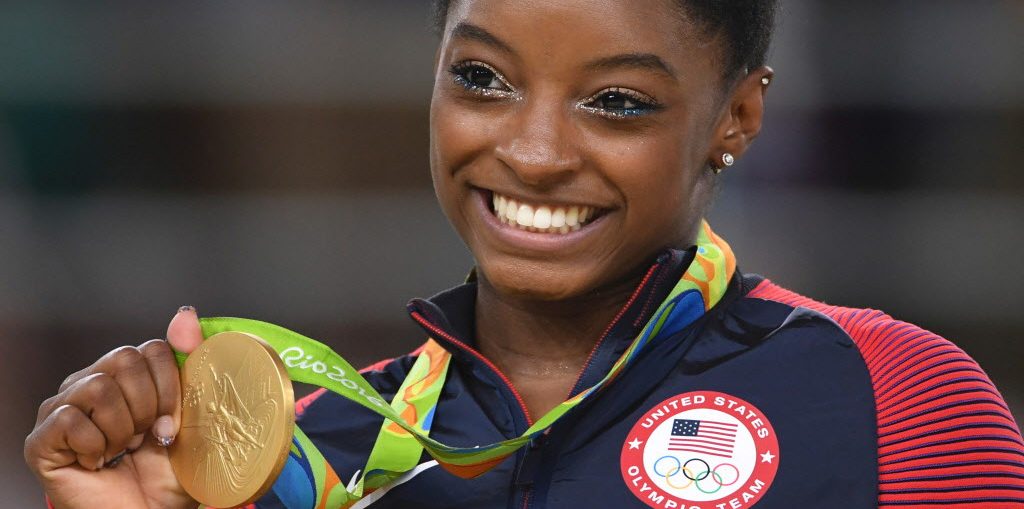
Simone Biles tried to treat the 2016 Summer Olympics like just your average ordinary gymnastics meet. So what if the stage and the stakes were different?
The floor was still the floor. The vault still the vault. The uneven bars still uneven. The balance beam still a four-inch wide test of nerves.
And the 19-year-old with the electric smile and boundless talent was still the best in the world. Maybe the best of all-time.
Over the course of 10 days in August, the biggest meet of her life ended like pretty much all the others in the four years that came before it, with Biles standing atop the podium, a gold medal around her neck and the sport she’s redefining one boundary-pushing routine at a time staring up at her. Not that she remembers any of it.
“It’s kind of a blur,” Biles said.
Maybe to Biles, but not to the rest of the world. Her massive haul in Rio de Janeiro — a record-tying four golds to go along with a bronze for the dominant U.S. women’s team — propelled her to stardom and rendered her last name superfluous. Now there’s one more honor to add to what on Twitter is known simply as #SimoneThings: Associated Press Female Athlete of the Year.
In a vote by U.S. editors and news directors announced Monday, Biles received 31 votes out of a possible 59 votes. U.S. Olympic swimmer Katie Ledecky, who won four golds and a silver in Rio, finished second with 20 votes. Serena Williams, who won Wimbledon for the seventh time to tie Steffi Graf’s record of 22 Grand Slam titles, and three-time AP women’s NCAA basketball Player of the Year Breanna Stewart tied for third with four votes each.
The AP Male Athlete of the Year will be announced Tuesday.
Biles became the fifth gymnast to win the honor, joining Olga Korbut in 1972, Nadia Comaneci in 1976, Mary Lou Retton in 1984 and Gabby Douglas in 2012. It’s company Biles joined while completing a run of dominance that included three straight all-around World Championships, an unprecedented run at the top in a sport where peaks are often measured in months, not years.
The teenager from Spring, Texas, hardly seemed burdened by the outsized expectations. If anything, she embraced them. She opted out of a verbal commitment to compete collegiately at UCLA to turn professional so she could cash in on the lucrative opportunities afforded an Olympic champion, a bit of a gamble considering the window is so narrow and directly tied to success at the Games.
Yet Biles seemed immune to it. At least on the outside. Inside, there were more than a few butterflies when she stepped onto the floor during team preliminaries on Aug. 7. They vanished the moment she stepped onto the green and cream colored floor at Rio Olympic Arena as she and the rest of her “Final Five” teammates — Douglas, Aly Raisman, Laurie Hernandez and Madison Kocian — put on a clinic that showcased how substantial the gap between the Americans and the rest of the world has grown.
Then again, the gulf between Biles and every other gymnast on the planet — even her good friends in red, white and blue — may be even wider.
“In prelims I did very well I kind of shocked myself,” Biles said. “I came in thinking, ‘I’ve been to three worlds.’ I knew the gist of it. Once I got [prelims] out of the way, I just kind of relaxed.”
What followed was a run of brilliance: a team gold as a fitting sendoff to retiring national team coordinator Martha Karolyi. Another in the all-around two days later, where her score of 62.198 bettered Raisman by more than two full points, the gymnastics equivalent of winning a football game by three touchdowns. A third gold came on vault, the first ever by an American woman at the Olympics and Biles’ first in major international competition to fill the only hole in her increasingly peerless resume.
A bronze on beam followed thanks to a messy landing on a front flip, her only major form break in Rio. No matter, she put the exclamation point on her gold rush with a gravity-escaping floor routine that ended with Biles rushing to embrace longtime coach Aimee Boorman as their long journey to this moment ended in triumph.
The ensuing four months have been a whirlwind. Biles carried the U.S. flag at closing ceremonies, published her autobiography, took part in a post-Olympic tour with her teammates (including performing in eight shows despite a fractured rib) and hung out at the White House with the president. She remains open to giving it another shot in Tokyo in 2020. That’s for later. In January she’ll sit down and plot out her goals for the upcoming year. For the first time since she can remember, gymnastics won’t be on the list.
It’ll be weird, sure. That’s not necessarily a bad thing.
“I miss training with the girls and having a good time,” Biles said. “Whenever I go to the gym to visit them and I see them, I do not miss this part at all right now.”